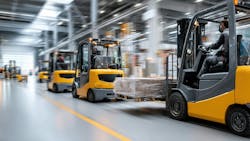How to Configure Forklifts: From Off-the-Rack to Complete Customization
What should buyers consider when choosing a new forklift? Capacity? Terrain? Power? Ergonomics? And that’s just determining operating requirements. Turning to equipment, accounting for options and even special engineering features create a spectrum of lift trucks that range from standard to customized offerings.
A properly equipped forklift can provide significant benefits to an operation in terms of productivity and total cost of ownership. But to enjoy those benefits, operations must understand the pitfalls of over- and under-equipping their lift trucks, how to determine the degree of customization required for their industry and application, and how to create a configuration that strikes a balance between upfront cost and long-term benefits.
Finding the Balance between Over- and Under-equipping
Configuration requirements vary widely depending on the type of lift truck and application, but it is important to strike a balance between “too much” and “not enough.”
Over-equipping a lift truck with features that aren’t needed ultimately creates a higher upfront cost. Sometimes, these features are baked into the design. For example, some lift trucks incorporate features like a full lighting package as standard equipment, but if the truck is always going to be used in well-lit areas, or only during daylight hours outside, the lights may not be necessary. But their cost is folded into the price of the truck.
Apart from cost considerations, over-spec’ing lift trucks presents a number of practical concerns. Each feature—even if it does not get used—is a potential “opportunity” for additional maintenance or replacement over the life of the truck. If a feature is not justified by an application, its presence can also introduce unnecessary complexity, introducing the need for further operator training.
There are also definite disadvantages to under-spec’ing lift trucks. Lower-cost trucks that are equipped for occasional or light duty cycles tend not to stand up well to hard or intense operations. If the truck is struggling to perform the job at hand, it slows down the operation and negatively impacts productivity and key performance indicators (KPIs). An imbalance between the truck and the requirements of the job can also make breakdowns more likely, further undercutting productivity and increasing maintenance and repair costs. Avoid under-spec’ing by making sure that the features and performance are up to the task at hand.
Forklift Configuration Possibilities
When configuring a lift truck there are several fundamental factors that must be weighed to help make it a good fit for the job.
Load
It is best practice to start specifying the lift truck based on the loads it is expected to handle. Consider weight, size and how high loads must be lifted. Typically, the heaviest loads and/or the load that needs to be lifted the highest should have the greatest influence on truck specification, but all loads should be considered.
Hours in Use
The age of a forklift is measured in hours rather than years, so the expected use plays a significant role in lift truck configuration. It helps determine maintenance schedules, predict equipment lifespan, optimize performance for efficiency and safety, and in the case of electric lift trucks, helps determine the required battery capacity and charging schedule.
Environment
The environment in which the lift truck operates also figures heavily in the configuration process. Initially it’s important to think through the physical dimensions of the work area, such as aisle widths, turning areas, doors and ramps. Further factors to consider include indoor and outdoor use, the surrounding temperature, altitude and terrain.
Power Source
Decisions around power source are not limited to just the truck itself, especially when shifting to a different power source. Questions arise about the need to add or change infrastructure and how to manage the switch across an entire fleet. This is particularly true for operations transitioning from internal combustion engine to electric power. An electrification expert from a forklift dealer or manufacturer can perform an evaluation of your operation to determine whether electric trucks are a good fit.
Telemetry Data
If available, telemetry data from an operation’s current truck fleet can be invaluable to inform proper lift truck configuration. In addition to providing an accurate picture of how many hours trucks are in use, telemetry tracks maintenance and repair information, making it easier to make better-informed decisions for the entire fleet.
Understanding All Configuration Options
The breadth of available options varies widely by manufacturer. Some manufacturers have a large variety of configuration options but a smaller line of trucks, making under- and overselling much more likely. Others have a broad line of trucks, each with a variety of standard features with a relatively small number of available options. Top manufacturers, on the other hand, offer both a broad line of trucks and a deep pool of options ranging from existing technologies and features to custom-engineered solutions.
Regardless of the level of customization, it is advantageous to choose a manufacturer that has both a wide range of options and the ability to custom-tailor options to meet operational needs. In addition to the advantages of being able to closely match the truck specification to specific applications, custom engineering tends to drive improvement across the manufacturer’s entire product line. When the manufacturer recognizes a feature as being of value to one customer, it is often made available as a new option for other customers, or even incorporated as a standard feature.
Balancing Upfront Costs and Long-term Potential
Ideally, operations should come into the configuration process with specific metrics or KPIs that they would like to meet. But, at the very least, they should have a clear, data-driven understanding of their application. For example, perhaps a business wants to move 300 one-ton loads per eight-hour shift. They could have one very busy truck or, alternatively, they could invest in a double pallet handler and a truck with a higher load capacity to halve the number of journeys. That means spending more initially in terms of customization, but that additional cost is offset by a reduction in running costs over time.
Another option might be to use lower-cost trucks to move the pallets horizontally and then another truck to store vertically. In most situations there is usually more than one viable solution. Operations can benefit from working with a manufacturer or dealer that understands their business and can help guide the purchase and configuration process to deliver a best-fit solution.
Configuring the Right Truck for Your Operation
With all the configuration options available, avoiding over- or under-equipping lift trucks should always come back to an analysis of what the job and environment require balanced against the monetary considerations of up-front cost, impact on productivity and cost over time.
A good lift truck provider will always start by gaining a thorough understanding of an operation’s application and, as a starting point will—if possible—suggest a standard solution to meet their needs, typically saving time and money. For applications that require special options, working with a manufacturer that has a dedicated special engineering team is important to achieving the right level of customization.
These experts can tap into specialized knowledge and experience gained from other users with similar applications to develop a lift truck that is equipped to best fit the application at hand. Plus, the benefit of working with a manufacturer with a specialized engineering team is that operations get the same factory-backed support for a custom-configured truck as they get for an off-the-rack version.

